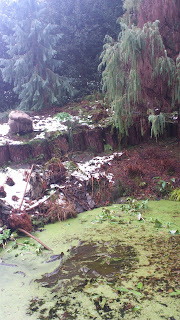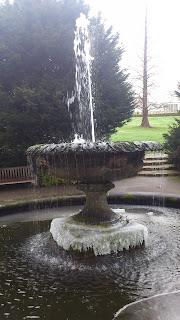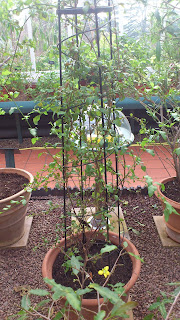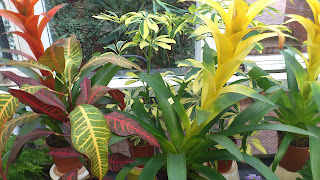The Secret Garden










The film 'The Secret Garden' tells the story of a garden which is unused and empty. The plants and flowers have died and it is a barren place. When it is used, cared and enjoyed it comes back to life; flourishing and blossoming.
I like this idea that when a place is unused it dies, and only comes back to life when it is used. With the increasing amount of empty shops in the High Street at the moment
"And over walls and earth and trees and swinging sprays and tendrils the fair green veil of tender little leaves had crept, and in the grass under the trees and the gray urns in the alcoves and here and there everywhere were touches or splashes of gold and purple and white and the trees were showing pink and snow above his head and there were fluttering of wings and faint sweet pipes and humming and scents and scents. And the sun fell warm upon his face like a hand with a lovely touch. ..under the plum-tree, which was snow-white with blossoms and musical with bees. It was like a king's canopy, a fairy king's. There were flowering cherry-trees near and apple-trees whose buds were pink and white, and here and there one had burst open wide. Between the blossoming branches of the canopy bits of blue sky looked down like wonderful eyes."
The Secret Garden
~ ~ ~
Hanging Gardens of Babylon
Josephus (ca. 37–100 AD) quoted Berossus (writing ca. 280 BC), when he described the gardens. Berossus described the reign of Nebuchadnezzar II, the king he credits with the construction of the Hanging Gardens.
“In this palace he erected very high walks, supported by stone pillars; and by planting what was called a pensile paradise, and replenishing it with all sorts of trees, he rendered the prospect an exact resemblance of a mountainous country. This he did to gratify his queen, because she had been brought up in Media, and was fond of a mountainous situation.”
Diodorus Siculus (active ca. 60–30 BC) seems to have consulted the early 4th century BC texts of Ctesias of Cnidus for his description of the Hanging Gardens:
"There was also, beside the acropolis, the Hanging Garden, as it is called, which was built, not by Semiramis, but by a later Syrian king to please one of his concubines; for she, they say, being a Persian by race and longing for the meadows of her mountains, asked the king to imitate, through the artifice of a planted garden, the distinctive landscape of Persia."
The Hanging Gardens have interested me as they were reportedly built by a Syrian King for his Queen how was homesick for her Persian coutryside and gardens.
I can relate to this in that I was brought up in the countryside and often miss this in Birmingham, and relish the parks and gardens in the city, as well as urban gardens.
~ ~ ~
Garden of Eden
The biblical garden of God, depicted as a garden of paradise.
~ ~ ~
Garden of Paradise
Paradise is a place in which existence is positive, harmonious and timeless. It is conceptually a counter-image of the miseries of human civilization, and in paradise there is only peace, prosperity, and happiness. Paradise is a place of contentment, but it is not necessarily a land of luxury and idleness. It is often used in the same context as that of utopia.
~ ~ ~
Persian Gardens
The Persian word (paradeisoi), from which our word paradise comes, meant a walled garden. It derives from pairi (around) and deaza(wall).
Paradise gardens were a calm retreat from the noisy and dusty outside world. They were used more as ornaments to be viewed from upper windows, or garden pavilions, than as rooms for outdoor living. Water channels, pools, fountains and cascades cooled the air. Flowers provided scent and colour. Fruit trees provided shade.
~ ~ ~
My first visit to a Botanical Gardens. Edgbaston Botanical Gardens was opened in 1832, with the Glasshouses added in 1852. The variety of plants, victorian architecture and ways of displaying the plants has become a large influence on my own work. I have begun to look deeper into Victorian botany.
~ ~ ~
Winterbourne Botanical Gardens
Another Botanical gardens in Birmingham. It is an Edwardian Arts and Crafts suburban villa garden, with many glasshouses and conservatories.
~ ~ ~

Great Western Arcade
The Great Western Arcade is a historical arcade in the centre of Birmingham.
I chose this arcade to approach due to it's history and architecture. It was built in 1876, and was strongly influenced by Joseph Paxton's Crystal Palace in Hyde Park.(see below).
Both are traditional Victorian buildings strongly representing glasshouses and displaying the arched windows very similar to those in the botanical gardens I have visited.
It is such a beautiful space, with quite a few empty shops. I think it's such a shame for there to empty windows in this arcade and it needs a display which will 'bring it back to life'.
~ ~ ~
Victorian Botanics
Botany was among the most popular sciences of the nineteenth century. It was cheap, easy and considered genteel enough for all classes to contribute.
Botanical Gardens have become a big influence on my work. I really admire the combination of the traditional Victorian architecture and the wild, slightly overgrown look of the plants.
~ ~ ~




Botanical drawings

I really like the vintage Victorian botanical drawings and find my own sketches looking very similar to these.
~ ~ ~
Ruskin building
As the degree show is taking place in Ruskin Hall, this links really well with my work.
Ruskin was a leading art critic of the Victorian era and was himself an amateur botanist. I have proposed to the designers of the degree publication that they incorporate the botanical theme of my work into the publication, which would then link well to my sample of flowers being displayed in the show.























































No comments:
Post a Comment